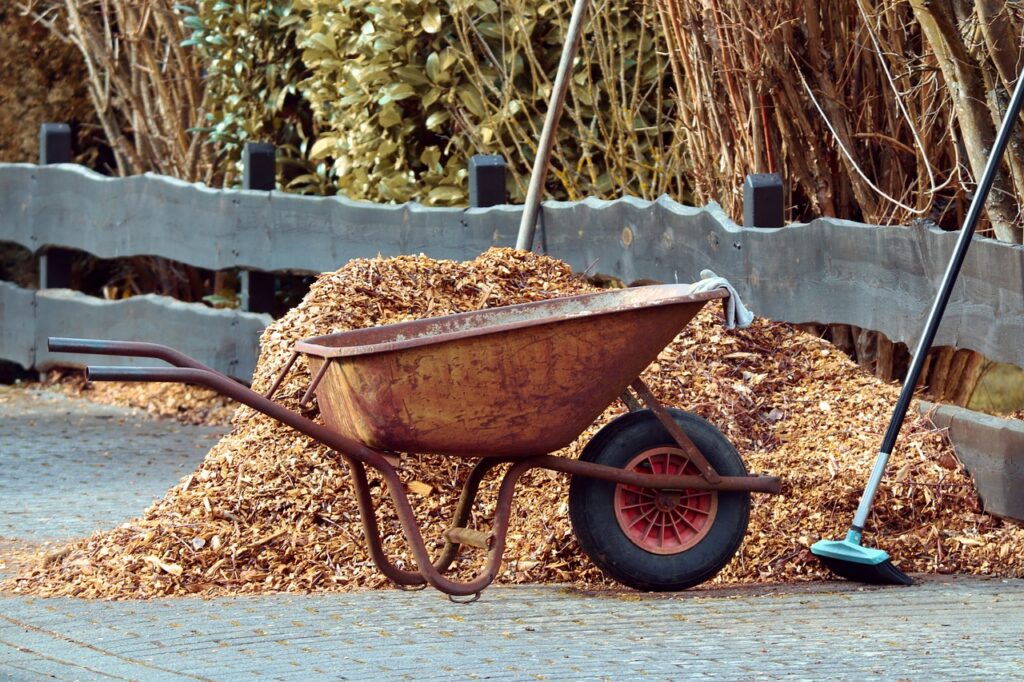Mulching Around Trees, Hedge, and shrubs
Woody vegetation such as trees, shrubs and hedges are invaluable to any landscape, providing daily shade during the warm days, aesthetic beauty, oxygen, and habitat for wildlife. However, those in urban or suburban environments, often face environmental stresses such as compacted soils, competition from lawns, chemicals from pollution or road salt, and exposure to pests and diseases. When done correctly at the right time of year, generally in late autumn to late winter, Mulching offers a practical, low-cost way to promote the plant health.
Moisture Retention is important for woody vegetation.
Trees need consistent moisture to thrive. In natural forest environments, a layer of fallen leaves and organic material helps trap moisture around tree roots, allowing for a slow, steady release of water. Mulch mimics this natural process, helping to hold water in the soil by reducing evaporation. This is especially beneficial in dry or drought-prone climates where water retention is critical.
So, do you remove the leaves, twigs, and seeds around a tree? Not always. it’s best to leave it as this is natural and what the tree or shrub would be used to in its natural setting.
When mulching around trees the mulch acts as a sponge, soaking up rainfall or irrigation water and slowly releasing it into the soil as needed. This reduces the need for frequent watering, making it an effective strategy for water conservation. For young trees, which require more moisture to establish their root systems, mulch provides an additional advantage by keeping the surrounding soil consistently damp, thus promoting healthy growth.
Mulching around trees in the autumn or late winter when the soil moisture content is at its highest is the best as the soil moisture content is at it highest.
If the soil compacted, then decompaction such as lightly forking or air spading is recommended to break up the soil.

Soil Temperature Regulation
Roots are highly sensitive to fluctuations in soil temperature. During the summer, the soil around a tree’s roots can become overheated, while winter temperatures can cause it to freeze. A good layer of mulch at a minimum of 5cm insulates the soil, moderating these temperature extremes. This insulation protects roots from stress during harsh weather conditions.
In colder climates, mulch helps keep the soil from freezing as deeply, which can prevent root damage and support continued, albeit slower, root activity during winter months. Similarly, in hot climates, it prevents the soil from reaching extreme temperatures, reducing stress on the root system.
Nutrient Enrichment
Mulch is more than just a protective layer; it’s also a source of organic material. Over time, natural mulches like wood chips, leaves, or pine needles decompose, adding valuable nutrients to the soil. This organic matter improves soil structure, boosts microbial activity, and increases nutrient availability, which all contribute to root health.
The type of chip used has a bearing upon its impact on nutrients. Woodchip from fruit trees is rich in sugar and can act as a stimulant whereas willow woodchip contains salicylic acid which is antiseptic to soil-based fungal diseases such as honey fungus.
Soil with rich organic content supports beneficial organisms such as earthworms and mycorrhizal fungi. These organisms play essential roles in breaking down organic material and releasing nutrients, making them more accessible to the tree. Additionally, well-decomposed mulch improves soil aeration, allowing roots to access oxygen more easily.

Weed Suppression
problematic for young trees, which are still establishing their roots and are more vulnerable to competition. Mulch acts as a natural weed suppressant by blocking light, inhibiting weed germination, and reducing the growth of invasive plants around the tree’s base.
Particularly if topped up on a 36month cycle.
By suppressing weeds, mulch reduces the need for chemical herbicides, which can harm tree roots if applied too close. It also decreases the time and effort spent on manual weeding, making it an environmentally friendly and low-maintenance option for tree care.
Protection Against Physical Damage
In urban landscapes, trees are often subjected to physical stress from lawn equipment, foot traffic, and nearby construction. What is termed mechanical damage? Mulching around trees provides a buffer zone around the tree, protecting its base and exposed roots from mechanical damage caused by lawnmowers and trimmers. These tools can wound the tree’s bark, creating an entry point for pests and diseases that can threaten tree health.
A well-maintained mulch ring around the tree also serves as a visual reminder for people to keep their distance, minimizing the risk of accidental damage from foot traffic or recreational activities.
Best Practices for Applying Mulch Around Trees
While mulching offers numerous benefits, improper mulching can harm trees. Here’s how to apply mulch correctly:
Choose the Right Mulch Material
Natural, organic mulches like wood chips, shredded bark, pine needles, and composted leaves are ideal for trees. These materials decompose over time, adding organic matter to the soil. Avoid dyed or artificially treated mulches, which can introduce chemicals into the soil, potentially harming the tree.
Wood chips are especially popular for tree mulching because they decompose at a moderate rate, providing long-lasting benefits. Fresh wood chips, however, can temporarily deplete nitrogen in the soil, so it’s best to let them age or use them in a thin layer if they’re not already composted.
The use of woodchips from trees with pathogen such as sudden oak decline is not recommended as this is pathogen pathway.
Spread Mulch in a Wide, Even Layer
To effectively support tree roots, mulch should be spread in a broad ring around the tree, ideally extending out to the drip line, which is the area beneath the outer edges of the tree’s branches. This wide distribution provides the greatest benefit by protecting the maximum root area and enhancing moisture retention. A minimum mulching layer of 2-4m from the base of the tree is ideal.
Apply mulch in an even layer, about 2 to 4 inches deep. Too much mulch can lead to excessive moisture retention and root rot, while too little mulch may not provide enough benefits. Raking the mulch periodically helps maintain an even layer and prevents compaction.
Avoid the “Volcano Mulch” Technique
One of the most common mistakes when mulching around trees is piling mulch up against the tree trunk in a “volcano” shape. While it may look aesthetically pleasing to some, this practice can harm the tree. Mulching too close to the trunk traps moisture, encouraging rot and creating a breeding ground for pests and diseases.
Instead, keep the mulch at least a few inches away from the trunk to allow airflow. This gap prevents moisture buildup around the base of the tree, protecting the bark and reducing the risk of fungal infections.
Maintain and Refresh Mulch Annually
Over time, mulch decomposes, which is a good thing for soil health but also means it needs to be replenished. Refresh the mulch layer annually, adding just enough to maintain the desired depth. Avoid piling new mulch on top of old layers without first loosening or removing the compacted base layer, as this can lead to an overly thick layer that prevents water and air from reaching the soil.
Removing and refreshing the mulch also allows you to check for pests, diseases, or signs of root rot, helping you address any issues early.
Mulching Mistakes to Avoid
Even with the best intentions, improper mulching can lead to problems. Here are some common mistakes to watch for:
Applying excessive Mulch
More mulch is not always better. Mulch that’s too thick traps too much moisture, leading to waterlogged soil and root rot. Excess mulch can also restrict oxygen flow to the soil, suffocating the roots. Always aim for a moderate layer—about 2 to 4 inches deep—and avoid adding additional layers on top without removing old mulch.
Using Inorganic Mulch Around Trees
Inorganic mulches like rubber or gravel don’t break down and offer no nutritional benefits. They can also increase soil temperature and create drainage issues. While these materials may be suitable for decorative beds or paths, they aren’t ideal for trees that rely on nutrient-rich organic matter.
Unclean stone may cause a chemical reaction with a tree and its decline. We have seen this when clients have called and asked why newly planted trees are not thriving only to find contaminated gravel around the base of the tree.









